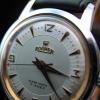Nice 23 Jewel Russian Sekonda Bought From The Bay..
-
Recently Browsing
- No registered users viewing this page.
-
Topics
-
Posts
-
Yes, "Sold out" is difficult to understand. There doesn't seem to be a lot going on. It's been nine months since any new video was published on the Watch Repair Channel. The Level 4 course on watchfix.com has been in progress for what feels like forever (several years!?). Maybe Mark's enterprises aren't doing well or perhaps already so profitable there's nothing much to motivate him for more material. Or, perhaps these days he's more into crochet. The real reason is probably something entirely different but it would be nice/interesting to know. I don't mean to sound gloomy or pessimistic, but I wouldn't be surprised to be met by an HTTP 404. Every day feels like a gift.
-
By nickelsilver · Posted
Steel has some funny properties, or at least counterintuitive. The modulus of elasticity is effectively (not exactly, but close enough) the same for steel that is annealed and hardened. What changes is the point of plastic deformation* . If the movement of your spring doesn't pass that, it should work fine. It looks a little thick, I would thin it a bit maybe from the main body out about halfway, maybe 10-20% thinner (not in thickness, along its form). But if it works it works! *So- if you have two bars of the same steel, one annealed, one at 600 Vickers (general hardness watch arbors might be), clamp them to a table so the same length is hanging out, and put a weight on the ends, they will bend the same amount. But if you continue to add weight, then remove it, at a point the annealed bar won't return to its original straightness. That's the point of plastic deformation. But up to that point, as springs, they are the same. However- their wear characteristics will be very very different. And getting the hardened bar past its point of plastic deformation takes a lot more effort. -
@JohnR725 now that you've mentioned it. This is actually the second aftermarket spring (same place and brand) I ordered as the first one broke. The eye on which the arbor pulls on, broke off on the first spring after the first wind, and also it was a bit to large for the arbor. Looked like on one the second picture in the 2nd group. The second one was exactly the same, I had to bend it a bit, to give it a more prominent curve to the end of the spring so that the arbor catches the eye. Also I believe both were 5-10mm shorter. Not that I writing that, I feel a bit dumb, as the spring might actually been the problem all along, although its advertised as a substitute to the original...
-
The CS70 is the only one they show as annealed. A further search on ebay, I found CS75 and CS100 annealed carbon steel strips e.g. https://www.ebay.co.uk/itm/314072784422
-
By Hawaiikook808 · Posted
Aloha and thanks for catching all these small but important details, John. I'm going to give it a shot. The good news is I have a parts movement here with a perfect complete balance. I will place them side by side for visual reference when doing what you outlined. It's been a while were I've had a hobby in which I joined a forum. I forgot just how helpful everyone can be. Mahalo. Frank.
-







Recommended Posts
Join the conversation
You can post now and register later. If you have an account, sign in now to post with your account.
Note: Your post will require moderator approval before it will be visible.